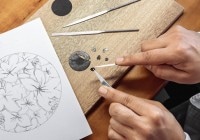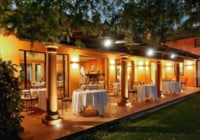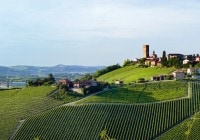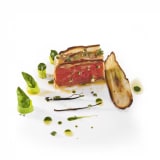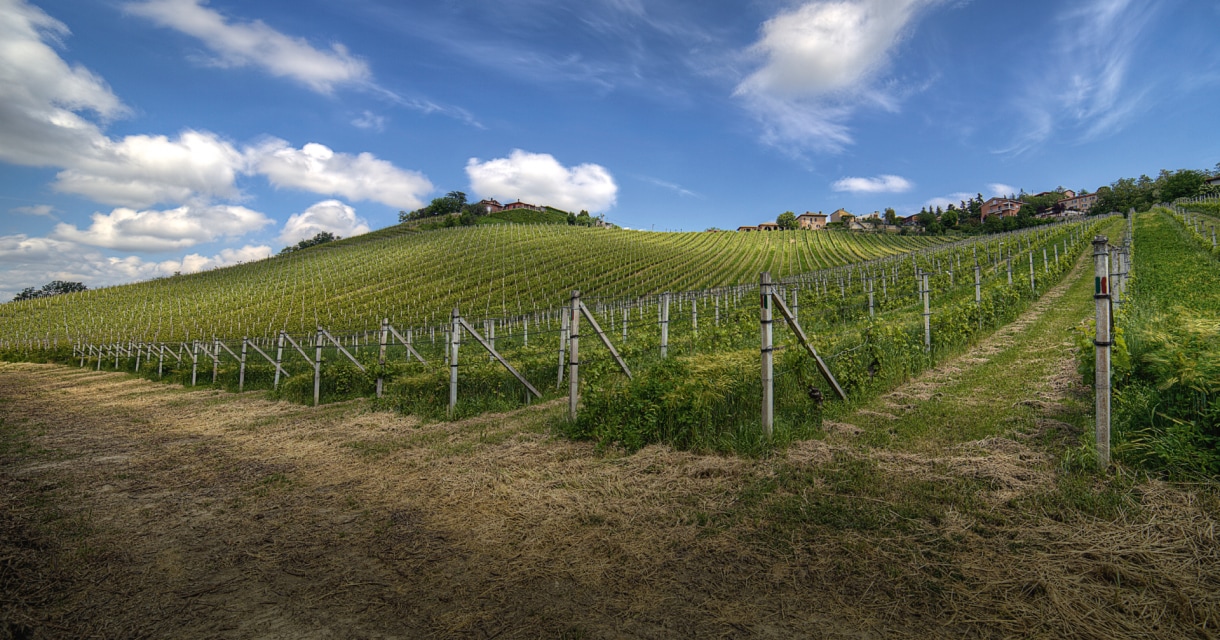
Search in Issues
Chapters
List of parts
Chapter 5
Dal Pescatore
Imagine a tableau of farmland and serene rural life and place in its center a beacon, which would be no less than Italy’s most acclaimed restaurant, Dal Pescatore.
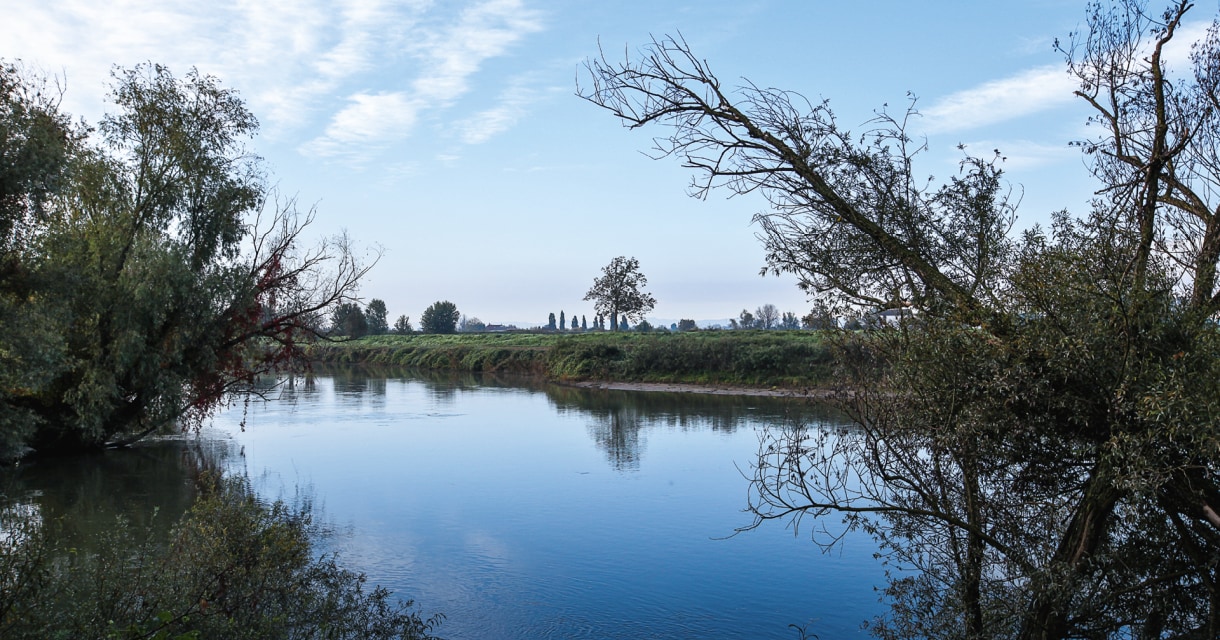
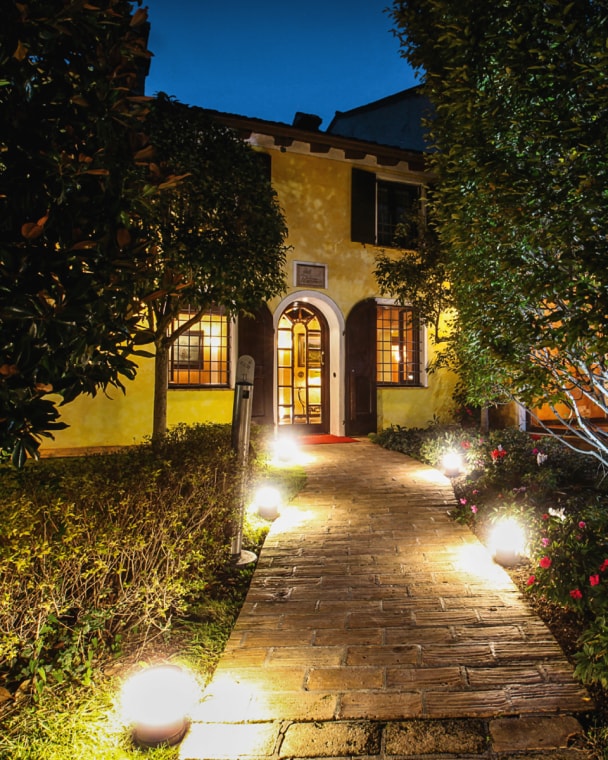
FAMILY TRADITION runs deep within Dal Pescatore as this has been the Santinis’ restaurant for NEARLY A CENTURY.
Conjure a mental picture. Imagine an essentially flat expanse in Northern Italy, unbroken for miles except for occasional narrow country roads and levees crisscrossing the landscape. The closest city, and, even then, a small one, at least a half hour’s drive away. Nearest large city two hours. Only one hotel within a radius of 5km, and that a rustic lodging fronting a desolate largely empty square offering only a church and a small café.
In the middle of your mental picture place a cluster of three small buildings.
What almost certainly has sprung to life in your mind’s eye is a tableau of farmland. Plowed fields, rolls of hay, grain silos, tractors, and perhaps grazing animals.
It is that cluster of three small buildings that likely embellished little in your mental portrait of serene rural life. But that cluster bears the name Runate and is a beacon which draws the food world here every midday and evening. Those buildings are home to what is no less than Italy’s greatest restaurant, the Santini family’s Dal Pescatore.
Every truly great restaurant has an aura, a texture, a tonality that goes beyond what’s on the plate. Dal Pescatore is no exception. After three plus hours cosseted and, of course, well nourished by the Santinis, what lingers is an impression which captures, better said, encapsulates, the interlude at the table. At Dal Pescatore that intangible distills down to an emotion: that of family warmth. Dal Pescatore is incontestably perched among the world’s gastronomic temples, having held the ultimate Michelin honor of three stars for twenty-three years, but, at its core, it is a family restaurant and it is the warmth of the Santinis that defines the generosity of the welcome, the setting, the service, and the food. The soft-spoken Nadia Santini in the kitchen with her elder son Giovanni; elegant Antonio Santini in the front of the house with his younger son Alberto the sommelier, enthusiastic and eager to share his encyclopedic knowledge of Italian wines and, thanks to his experience touring wine regions in France, America and Australia, those as well. And still present lending advice and tending the herb garden is Antonio’s mother Bruna. Family bonds run deep, extending beyond the three generations there today, as this has been a Santini restaurant for nearly a century.
The Dal Pescatore name is somewhat misleading as it suggests a fish restaurant. And, indeed, historically that’s what it was when originally founded in 1926 by today’s patron Antonio Santini’s grandfather, also named Antonio, and Antonio’s wife, Teresa. Named “Vino e Pesce”, its menu focused upon fried fresh water fish coming from the small stream behind the restaurant, an area that today is a nature preserve, and local Lambrusco wine. The style may have been that of a rustic country osteria, but some of the dishes endure today such as pike with parsley, anchovies and capers.
Antonio and Teresa’s son, Giovanni, well schooled by his parents, started the upward arc of Vino e Pesce as he and his wife Bruna began the first stages of the restaurant’s transformation. Cooking alongside her mother-in-law Teresa, Bruna not only introduced pasta onto the menus, she made it her specialty including what has evolved to become a classic of the house tortelli di zucca. As the menu expanded to include roasted meats, the restaurant moved upscale in its furnishings.
As it fully earned the mantle of “trattoria”, the time came to change the name to today’s Dal Pescatore.
The third generation of Santinis took the helm when Giovanni and Bruna’s son, Antonio, married Nadia, who today presides in the kitchen with her son, the fourth generation, Giovanni. It was Antonio and Nadia’s shared vision that once again transformed the then Dal Pescatore. On their 1974 honeymoon trip to France they visited many of the brightest stars in the Michelin cavalcade: Bocuse, Haeberlin, Troisgros, Savoy, Pic, Guérard, Vergé, Ducasse. Not only were their eyes opened to the glories of cooking at that level, they became inspired to elevate Dal Pescatore to the summit of three stars.

Three generations of the Santini family.
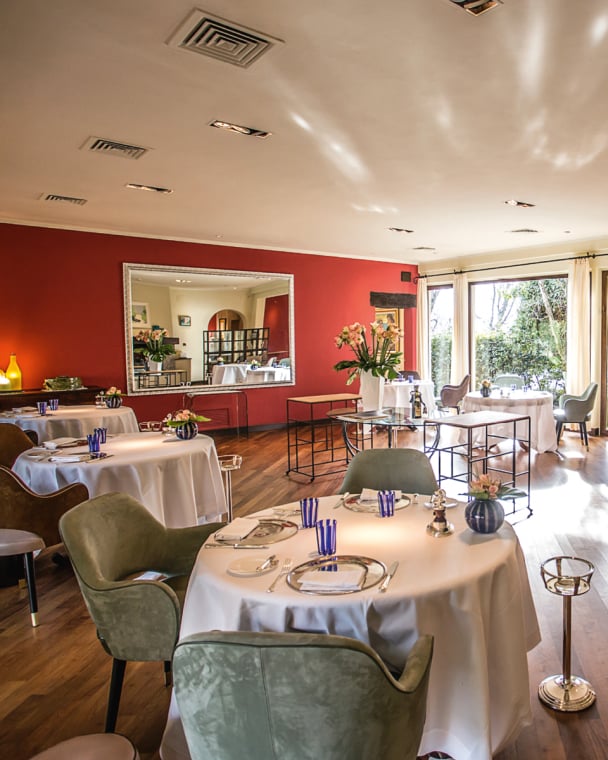
Each of the DINING ROOMS is graced with at least one full floor-to-ceiling glass wall with A VIEW FLOWING OUT TO A GARDEN.
What is remarkable is not just that Nadia’s cooking achieved this ultimate crown of three stars—one star in 1982, two in 1987 and three in 1996, an honor they have held continuously since—but that she did it without apprenticing elsewhere. The traditional career path to join the exclusive “club” of three-star chefs invariably includes sojourns in other prestigious kitchens, absorbing the recipes, techniques, styles, and, yes, tricks from other master chefs. Nadia, with of course guidance from Bruna, who likewise never apprenticed in another restaurant, did it on her own.
That is not to say that Antonio and Nadia isolated themselves from the larger gastronomic world. To the contrary, they became members of the prestigious groups Relais & Châteaux and Grandes Tables du Monde and there developed close friendships with many of cooking’s leading lights, particularly intimate with Paul Bocuse, with whom they dined three days before Paul’s death in January 2018, and Marc Haeberlin of Illhaeusern’s Auberge de l’Ill (likewise a Michelin three-star family restaurant and a personal favorite described in these pages in Issue No. 9). Marc and Antonio telephone each other every week.
Nothing in the surrounding agricultural landscape foretells the sophistication of the interior. Walls sponge painted in pastels, graceful arches over many doorways dividing the rooms, warm hardwood floors broken up with hand-made rugs, widely spaced tables, all woven together to form a tasteful luxurious ambiance that could only be Italian. The Santinis have, however, borrowed a page from the Japanese. Each of the dining rooms is graced with at least one full floor-to-ceiling glass wall with a view flowing out to a garden. Just as with a Japanese kaiseki restaurant or Kyoto tea house, the garden becomes part of the room.
There can be a degree of risk dining in a Michelin starred Italian restaurant, loss of the sense of place if favor has been curried with the Michelin inspectors by over-indulging in French fusion. Reading the Dal Pescatore menu with its abundant range of pastas and risottos put those fears to rest, further comfort coming from the overture to the tasting menu, Composta di pomodori e melanzane con basilico fresco. This was a square of compressed gloriously ripe Italian tomatoes poised atop a confit of eggplant bathed in basil infused Tuscan olive oil barely spotted with balsamico which the Santinis age and produce in their own barn at the rear of the property.
Of course, nothing signals fidelity, not only to grand Italian tradition but also to the history of Dal Pescatore, more than Tortelli di zucca (zucca, amaretti, mostarda e Parmigiano Reggiano). After all it was Bruna who introduced it to the menu during Dal Pescatore’s trattoria era. As these pages have always been plainly spoken, not ordering this dish is simply unimaginable for any visit to the restaurant and it alone easily justifies the two hour each way pilgrimage from Milano. These tortelli fully fit the Michelin definition of its coveted three-star rating as an experience that “merits a voyage”. A pillow of pasta, be it ravioli, tortelli, cappellacci, filled with pumpkin is a staple of Northern Italian cuisine. In many cases its preparation is elevated with the addition of the almond accents of amaretti. What sets Dal Pescatore’s version apart is the mostarda which is a confit of fruit punched up with mustard. The fruit varies with the season, most often it is white watermelon. The finesse, the perfection of their tortelli is other-worldly: salty, sweet, fruity, earthy.
A second pasta standout is Tortellini di Chianina con erbette al salto, cipole rosse di Tropea, crema di piselli e pergamena di topinambur. How often does the filling of tortellini get overwhelmed and diluted by the combination of the pasta itself and the sauce? Here the delicate and somewhat earthy Chianina beef farce shines through. The luminous green pea and Jerusalem artichoke sauce, served alongside, lends a subtle accent preserving the beef’s central role in the preparation.
A few sautéed spinach leaves and confit red onion provide counterpoints.
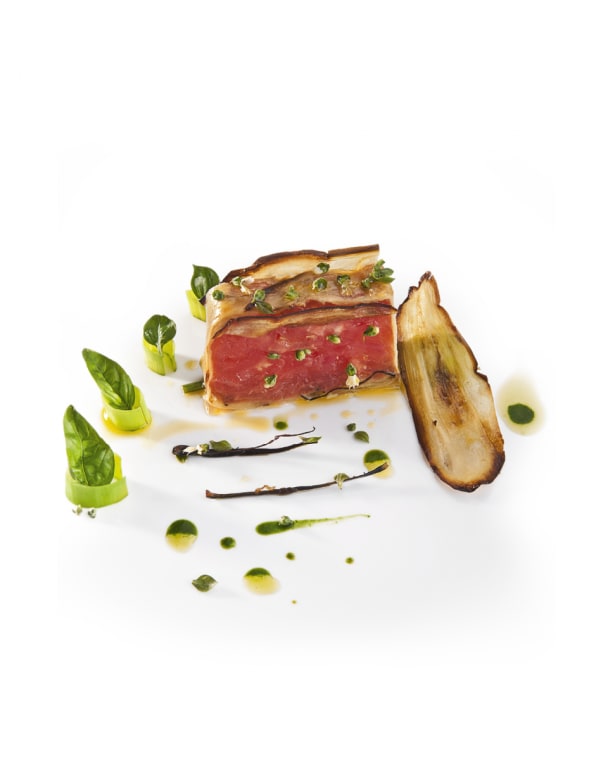
Composta di pomodori e melanzane con basilico fresco.
A triumph in all of its dimensions, including its dazzling color, is Risotto con piselli, asparagi, pane tostado alle erbe e bottarga di tonno. Resplendent with its brilliant fern green color, this is no less than an ode to Spring. Setting this preparation apart from ordinary pea or asparagus risotto where flavors are often muted with freshness lost, both vegetables announced themselves with brilliant intensity and freshness, with added interest furnished by the toasted black bread crumbs. The rice itself is more refined than the ordinary arborio used for risottos. It is a semifino flat variety, Vialone Nano, which is grown nearby outside of Mantua and Verona.
Plainly the Santinis revere vegetables. Misticanza dell’orto con orata marinata, mousse di melanzane, burrata e maionese allo zenzero is one of Giovanni’s creations. Several perfectly al dente carrot strips, placed vertically on the plate, are formed into the shape of the letter “P”, the hole filled with raw sea bream, the other al dente vegetables, eggplant mousse and burrata, all accompanied by ginger mayonnaise. The mark of a great chef is understanding the important role of texture on the plate, plainly Giovanni does.
One of the signature dishes leans toward France, Terrina di astice con caviale oscietra royal e olio extra vergine toscano. Why have terrines like this all but disappeared from so many of the world’s grand restaurants? Likely because they are not only labor intensive but excruciatingly demanding of precision in preparation. The generous slice of the terrine presented an abundance of cooked just to translucent lobster held in place by the bare minimum of lobster gelee. Balance was perfect as the generous dollop of caviar, far from taking over the dish, announced itself as a subtle seasoning, its saltiness acting to enhance the sweetness of the lobster.
Another nod toward France, at least in the choice of ingredient, is Coscette di rana gratinate alle erbe fini. The frog legs may signal Italy’s northwestern neighbor, but the preparation remains thoroughly planted on this side of the border. Italy spoke through the radicchio, balsamic and cheese served with the delicately tender legs.
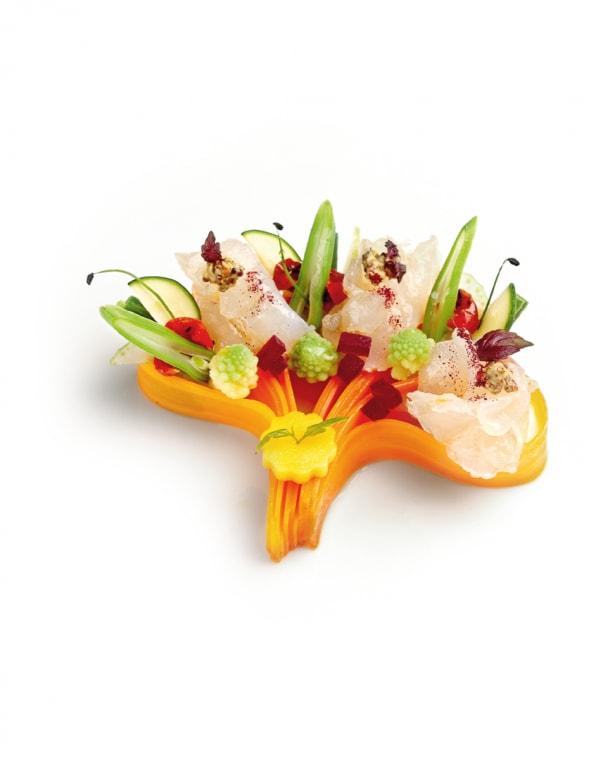
Misticanza dell’orto con orata marinata, mousse di melanzane, burrata e maionese allo zenzero.
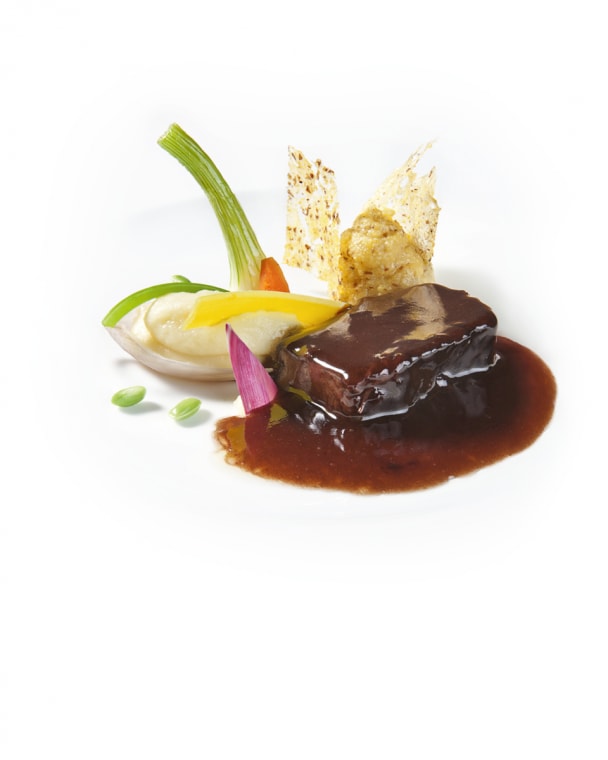
Cappello da prete di manzo al Nebbiolo e Polenta gialla di Storo.
Dal Pescatore SHOWCASES many LOCAL SPECIALTIES seldom found outside the region.
The primi piatti selection also includes a seared foie gras, Foie gras d’oca in padella con frutto della passione e vino passito. Seared foie gras with a slightly acidic sweet fruit pairing is a staple of fine kitchens around the world. The Santinis however bring a few twists to set theirs apart. First, they serve goose foie gras. With very few exceptions, seared preparations elsewhere are of duck. Can we link this to the close friendship with the Haeberlins who likewise specialize in goose foie gras, albeit generally serving it as a cold terrine? Second, the base of the passion fruit sauce is Passito Veneto I Capitelli, a sweet wine which comes from the area of the Veneto nearest Verona. It brings even more exoticism to the passion fruit sauce, adding notes of dried apricots, honey, mango and papaya. Naturally the ideal pairing is the same wine which Alberto generously offers.
Chatting with Alberto about Dal Pescatore’s veneration of Italian traditions, there were two secondi piatti that he was eager to spotlight. First is Cappello da prete di manzo al Nebbiolo e Polenta gialla di Storo. This is a slow-cooked beef and polenta that in multiple dimensions transcends the genre. The cut of beef is unique to the region. By carving the beef differently than is done essentially everywhere else in the world, local Mantua butchers are able to offer this prized cut from a section of the shoulder that would otherwise be lost. The result, following patient slow low-temperature cooking and napping with a deep concentrated beef reduction enrichened with earthy Nebbiolo wine, is ethereal. All of the shoulder collagen has long since been melted into the meat, producing other worldly tenderness and depth of flavor. The delicacy of the meat is matched by an extraordinarily refined Storo polenta from Trentino.
The second preparation he highlighted was eel, Anguilla alla griglia, servita con radicchio. This is a dish that appears simple, deceptively so. The Santinis are able masterfully to grill it to produce a glorious herbal crust while at the same time preserving the moisture and naturally springy texture of the eel.
Alberto’s favorite traditional dishes should not deflect attention from other standouts such as Sella di capriolo con salsa al Cabernet e mirtilli neri. Classicism reigns with this cooked perfectly rare saddle of venison married with a cabernet/blueberry sauce.
Despite its remote location, Dal Pescatore’s TOWERING VIRTUES fill the tables every lunch and dinner.
It is thrilling to see classic zabaione featured prominently on the dessert card. It is the star of Meringa con mousse di pistacchio, mandorle e zabaione al Marsala. Often zabaione is diluted with whipped cream in the name of lightness. Of course, that dims the full glory of what it should represent, decadent richness. The Santinis understand this, with two pools of zabaione, as it should be, flanking pistachio mousse that is topped with meringue, almonds and chocolate.
Zabaione is also featured in a cake dessert, Torta di amaretti (café, panna, croccante, zabaione). With its layers of different ingredients, it would not be wrong to imagine this as an Italian marjolaine cake. It offers up layers of cream mousse, zabaione and amaretti, all topped with crunchy caramelized almonds.
Of course, chocolate is offered with Fondente al cioccolato guanaya con crumble croccante al cacao, pere al profumo d’arancia e gelato alla vaniglia. Here a chocolate cake and mousse, done in the only moderately sweet Italian style, is paired with pear mousse and vanilla gelato. Classic and perfect.
Rather than string superlatives together describing Dal Pescatore, consider this. But for the brilliance of its cuisine, the warmth of the family welcome and the generosity of the Santinis, the remoteness of its location, nearly off the grid, would doom it to failure. To the contrary, Dal Pescatore’s towering virtues fill the tables lunch and dinner, notwithstanding the journey to come here. •
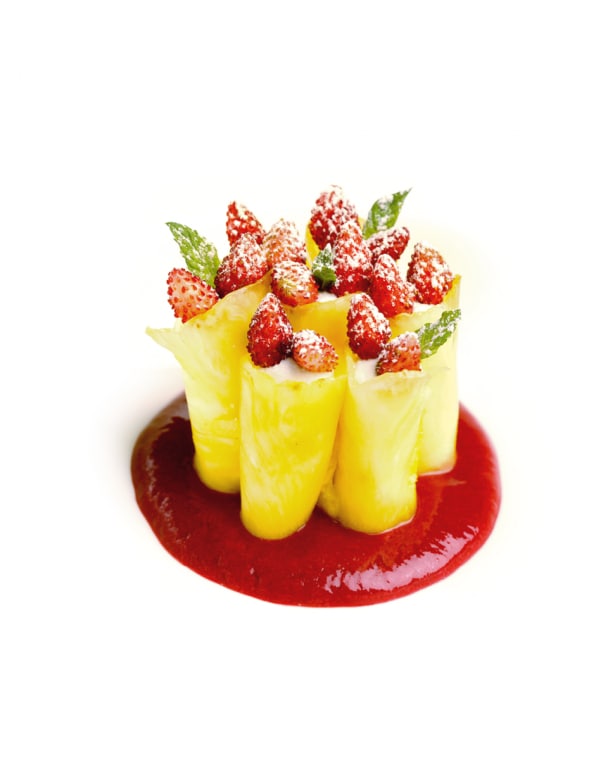
Maccheroni di ananas, crema alla vaniglia, fragoline di bosco e salsa di lamponi.
Other issues
Don't miss the latest issue
Sign Up for New Releases


